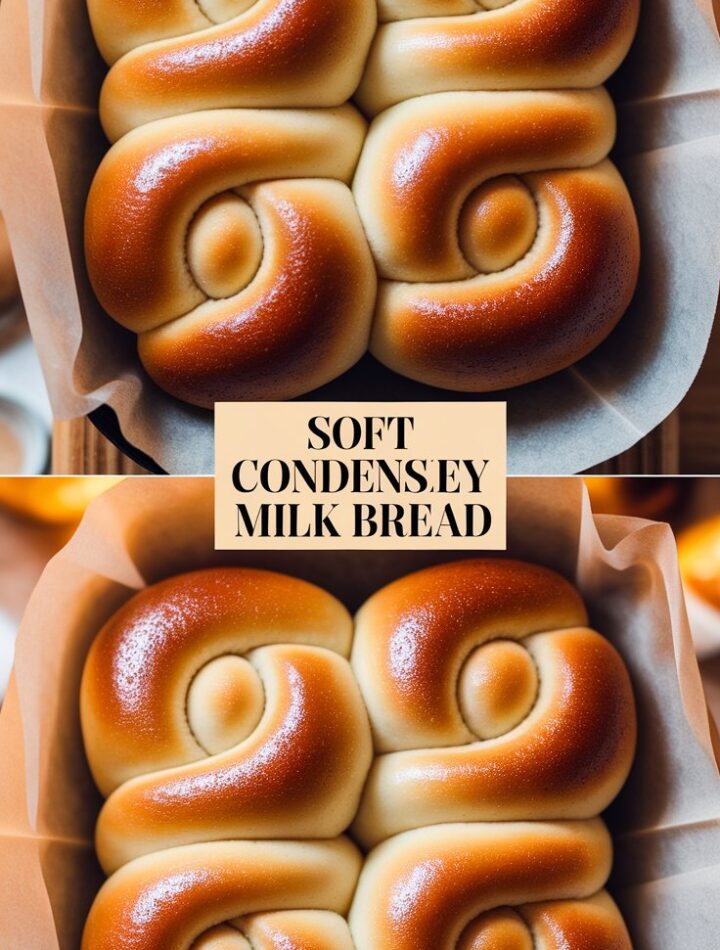There’s something magical about the smell of freshly baked bread wafting through the kitchen—a warmth that invites everyone to gather around the table. And when that bread happens to be Soft Condensed Milk Bread, you’re in for a truly comforting experience. This pillowy, melt-in-your-mouth loaf combines a light texture with just the right touch of sweetness, making it perfect for breakfast, brunch, or afternoon tea.
In this article, you’ll learn everything you need to know about making the softest, most delicious condensed milk bread right at home—from the ingredients and method to expert tips, variations, and FAQs. Whether you’re a seasoned baker or just starting out, this recipe is simple, foolproof, and guaranteed to impress.
Why You’ll Love This Recipe
Soft Condensed Milk Bread is more than just another homemade loaf—it’s the kind of bread that turns ordinary moments into little celebrations. Here’s why this recipe deserves a spot in your baking routine:
- Soft and Airy Texture: Each slice feels light as a cloud, thanks to the perfect kneading and yeast activation.
- Naturally Sweet: Condensed milk infuses the bread with sweetness without being overpowering.
- Versatile Use: Serve it warm with butter, use it for French toast, or make soft sandwiches that taste bakery-fresh.
- Easy to Make: Simple ingredients and clear steps make this recipe approachable, even for beginners.
- Smells Incredible: The sweet, creamy aroma fills your home with irresistible warmth.
- Kid-Approved: Its mild sweetness makes it a hit with kids (and adults alike!).
This bread has a beautiful golden crust and a soft white crumb inside that stays tender for days. Once you try it, you’ll want to make it again and again.
The Secret Behind Condensed Milk Bread
The star of this recipe—sweetened condensed milk—is what gives this bread its unique character. Unlike regular milk, condensed milk is rich, thick, and sweet. It adds both moisture and flavor, helping the bread stay soft for longer.
In many Asian and European bakeries, condensed milk bread is known for its luxurious texture and subtle sweetness. The sugar in the condensed milk also feeds the yeast, helping the dough rise better and achieve that signature fluffy consistency.
Ingredients You’ll Need
Let’s take a closer look at each ingredient and how it contributes to the perfect loaf.
For the Bread Dough:
- 3 cups all-purpose flour – The foundation of your dough. All-purpose flour provides structure while keeping the crumb soft.
- ¼ cup sugar – Enhances flavor and helps yeast activation.
- 1 teaspoon salt – Balances sweetness and strengthens the gluten.
- 1 tablespoon active dry yeast – The leavening agent responsible for that airy rise.
- ½ cup warm water (around 110°F / 43°C) – Activates the yeast; make sure it’s warm, not hot.
- ½ cup sweetened condensed milk – Adds sweetness, moisture, and that distinct creamy flavor.
- 2 tablespoons unsalted butter, softened – Gives richness and a tender crumb.
- ½ cup milk (whole or 2%) – Keeps the dough moist and enhances flavor.
- 1 large egg – Adds structure, color, and richness.
Optional Toppings and Add-Ins:
- Melted butter or egg wash (for a shiny crust)
- Shredded coconut, sesame seeds, or slivered almonds
- Chocolate chips, raisins, or dried fruit for a twist
Step-by-Step Directions
Follow these steps carefully, and you’ll have bakery-quality bread at home.
Step 1: Activate the Yeast
In a small bowl, mix the warm water, 1 tablespoon of sugar, and yeast. Stir lightly and let it sit for about 10 minutes, until the mixture turns foamy.
🧠 Tip: If the yeast doesn’t bubble, it’s likely inactive. Discard and start again with fresh yeast.
Step 2: Mix the Dry Ingredients
In a large mixing bowl, combine flour, remaining sugar, and salt. Stir until well distributed. This ensures even flavor throughout the dough.
Step 3: Combine the Wet Ingredients
In another bowl, whisk together condensed milk, milk, egg, and softened butter. Once the yeast mixture is bubbly, pour it into this wet mixture and mix until combined.
Step 4: Form the Dough
Slowly add the dry ingredients to the wet mixture, one cup at a time. Stir with a wooden spoon or spatula until a sticky dough forms.
💡 Tip: Don’t panic if the dough feels sticky at first—it will come together as you knead.
Step 5: Knead the Dough
Turn the dough out onto a floured surface and knead for 8–10 minutes, or until smooth and elastic.
You can test the dough by gently stretching it between your fingers—it should form a thin “windowpane” without tearing easily.
If using a stand mixer, knead on medium speed for about 6–7 minutes using the dough hook attachment.
Step 6: First Rise
Place the dough in a greased bowl, cover with plastic wrap or a damp kitchen towel, and let it rise in a warm, draft-free place for about 1 to 1½ hours, or until doubled in size.
🍞 Tip: The perfect spot for rising is your oven (turned off) with the light on—it creates gentle warmth ideal for yeast.
Step 7: Shape the Dough
Once risen, punch down the dough to release air bubbles. Shape it into a loaf or divide into rolls, depending on your preference.
Place the shaped dough into a greased 9×5-inch loaf pan.
Step 8: Second Rise
Cover again and let it rise for 30–40 minutes, or until the dough has puffed just above the rim of the pan. The second rise creates that light, fluffy texture.
Step 9: Bake
Preheat your oven to 350°F (175°C).
Bake the bread for 25–30 minutes, until golden brown on top and a toothpick inserted into the center comes out clean.
If the top browns too quickly, cover loosely with aluminum foil during the last 10 minutes.
Step 10: Cool and Enjoy
Once baked, remove the bread from the pan and cool on a wire rack. Brush with melted butter for a glossy, tender crust. Slice only after it cools slightly—it’s worth the wait!
Serving Suggestions
This soft condensed milk bread is wonderfully versatile. Here are a few ways to enjoy it:
- Classic: Serve warm with a pat of butter or drizzle of honey.
- Breakfast Treat: Toast slices and top with jam or Nutella.
- Sweet Sandwich: Pair with peanut butter and sliced bananas.
- French Toast: Turn leftover slices into rich, custardy French toast.
- Dessert Base: Use it for bread pudding or layered desserts with cream.
Texture & Flavor Notes
When you slice into this loaf, you’ll notice its fine, soft crumb and subtle milky sweetness. The flavor is delicate—not too sugary—making it ideal for both sweet and savory pairings. The condensed milk adds a creamy undertone, and the crust stays soft for days.
🧈 Pro Tip: For an even softer loaf, add 1 tablespoon of milk powder to the dough. It improves elasticity and flavor depth.
Expert Tips for Perfect Bread Every Time
- Measure Accurately: Use a kitchen scale if possible. Even small differences in flour or liquid can affect the texture.
- Check Water Temperature: If it’s too hot, yeast dies; too cold, it won’t activate. Aim for 105°F–110°F.
- Avoid Over-Flouring: A slightly sticky dough leads to softer bread. Too much flour creates dense texture.
- Let It Rise Fully: Don’t rush fermentation. Bread develops flavor and lightness during the rise.
- Use Fresh Yeast: Expired yeast is one of the most common causes of flat bread.
- Brush with Butter: It keeps the crust soft and gives a beautiful sheen.
- Cool Before Slicing: Cutting hot bread lets steam escape and can make the crumb gummy.
Variations to Try
Once you master the basic loaf, you can get creative with flavors and shapes. Here are a few delicious ideas:
1. Coconut Condensed Milk Bread
Add ¼ cup shredded coconut to the dough and sprinkle some on top before baking for a tropical twist.
2. Chocolate Chip Condensed Milk Bread
Fold in ½ cup mini chocolate chips for a sweet treat kids will love.
3. Cinnamon Swirl Bread
Roll the dough flat, sprinkle with brown sugar and cinnamon, then roll it up before placing it in the loaf pan.
4. Honey Butter Glaze
After baking, brush the loaf with a mix of 1 tablespoon honey and 1 tablespoon melted butter for a glossy, flavorful finish.
5. Savory Version
Reduce sugar to 1 tablespoon and add grated cheese or herbs for a soft, slightly sweet sandwich loaf.
Storage and Freezing
Bread made with condensed milk stays soft longer than most homemade loaves, but proper storage is key.
At Room Temperature:
Keep the bread in an airtight container or wrapped tightly in plastic wrap. It will stay fresh for up to 3 days.
In the Refrigerator:
Store in an airtight bag for up to 5 days. To restore softness, microwave slices for 15–20 seconds or toast lightly.
Freezing:
Allow the bread to cool completely. Slice it and wrap each portion individually in plastic wrap, then place in a freezer bag. It can be frozen for up to 2 months.
To serve, thaw at room temperature or warm in the oven at 350°F for 10 minutes.
Troubleshooting & Common Mistakes
Even simple recipes can go wrong if a few steps are missed. Here’s how to fix or avoid common issues:
| Problem | Possible Cause | Solution |
|---|---|---|
| Bread didn’t rise | Inactive yeast or cold environment | Use fresh yeast, and rise in a warm area |
| Dough too sticky | Too much liquid or humidity | Add flour 1 tablespoon at a time |
| Crust too hard | Overbaking or no butter wash | Bake slightly less and brush with butter |
| Dense texture | Insufficient kneading or rising | Knead longer and allow full proofing time |
| Bread collapsed | Over-proofing | Don’t let it rise past double size |
Nutrition Information (Per Slice)
(Based on 10 slices per loaf)
- Calories: ~200
- Carbohydrates: 30g
- Protein: 5g
- Fat: 7g
- Sugar: 10g
- Fiber: 1g
Note: Nutritional values vary based on specific ingredients used.
FAQs
1. Can I use evaporated milk instead of condensed milk?
No, evaporated milk isn’t sweet and won’t give the same creamy flavor. Stick to sweetened condensed milk for best results.
2. Can I make this bread without eggs?
Yes! Replace the egg with 1 tablespoon ground flaxseed + 3 tablespoons water (flax egg) or use a store-bought egg substitute.
3. What if I don’t have a loaf pan?
You can shape the dough into rolls or braid it. Adjust baking time to 20–25 minutes for smaller shapes.
4. Can I make this recipe dairy-free?
Yes. Substitute plant-based condensed milk (like coconut condensed milk) and non-dairy butter/milk.
5. Why is my bread too dense?
Over-flouring or under-kneading are common culprits. The dough should feel soft and elastic, not stiff.
6. How can I make this bread extra fluffy?
Try replacing 2 tablespoons of the flour with cornstarch—it makes the crumb even lighter.
7. Can I double the recipe?
Yes, just double all ingredients and divide the dough between two pans. Baking time might increase slightly.
8. Can I use instant yeast instead of active dry yeast?
Yes, skip the proofing step and add it directly to dry ingredients. Reduce total yeast to 2¼ teaspoons.
Pairing Ideas
This bread is beautifully adaptable. Try serving it with:
- Coffee or Tea: Its light sweetness pairs wonderfully with a morning cup.
- Homemade Jam: Strawberry or apricot jam adds a fruity contrast.
- Savory Butter: Try garlic or herb butter for a flavor upgrade.
- Fruit and Cream: Fresh berries and whipped cream for a dessert-like snack.
Baking Science: Why Condensed Milk Works
Sweetened condensed milk isn’t just a flavor booster—it changes how the dough behaves. The milk proteins tenderize gluten strands, resulting in a softer texture. Its natural sugars caramelize slightly during baking, giving that golden crust. Plus, the fat content adds richness and extends shelf life.
That’s why even one slice of this bread feels indulgent yet light. It’s the balance of science and comfort food in perfect harmony.
Storage Safety Tips
Always allow bread to cool before sealing it in containers; trapped steam can cause sogginess or mold. For longer freshness, line the container with a paper towel to absorb moisture. Never store warm bread in plastic wrap.
Pro Serving Tip: Sweet Milk Drizzle
If you want to make your bread feel bakery-special, drizzle a quick glaze over the top:
- Mix 2 tablespoons condensed milk + 1 teaspoon milk + a pinch of salt.
- Brush over warm bread and let it set—it adds shine and extra sweetness.
Baker’s Notes & Final Thoughts
Baking at home can feel intimidating, but this recipe proves it doesn’t have to be. With a handful of simple ingredients and a bit of patience, you can create a loaf that rivals any bakery.
The Soft Condensed Milk Bread is a celebration of simplicity—creamy, tender, and beautifully sweet without being heavy. It’s perfect for gifting, sharing, or keeping all to yourself.
Each slice carries a sense of comfort, nostalgia, and homemade joy. Whether you enjoy it plain, toasted, or transformed into something fancy, one thing’s for sure: it’s going to be a favorite in your kitchen.
You May Also Like
If you loved this Soft Condensed Milk Bread, you’ll enjoy:
- Coconut Pineapple Banana Bread – Moist, tropical, and perfectly sweet.
- Vanilla Bean Brown Butter Cheesecake – Silky smooth indulgence.
- Apple Pie Puff Pastry Bake – Crispy, cozy, and full of cinnamon flavor.
Conclusion
Soft Condensed Milk Bread is the perfect marriage of texture and flavor—soft, sweet, and utterly satisfying. With a simple process and reliable results, this loaf transforms everyday ingredients into something extraordinary.
So preheat your oven, grab that can of condensed milk, and get ready to fill your kitchen with the comforting scent of fresh bread. Once you take that first warm bite, you’ll understand why this recipe is truly a pillowy sweet delight.




